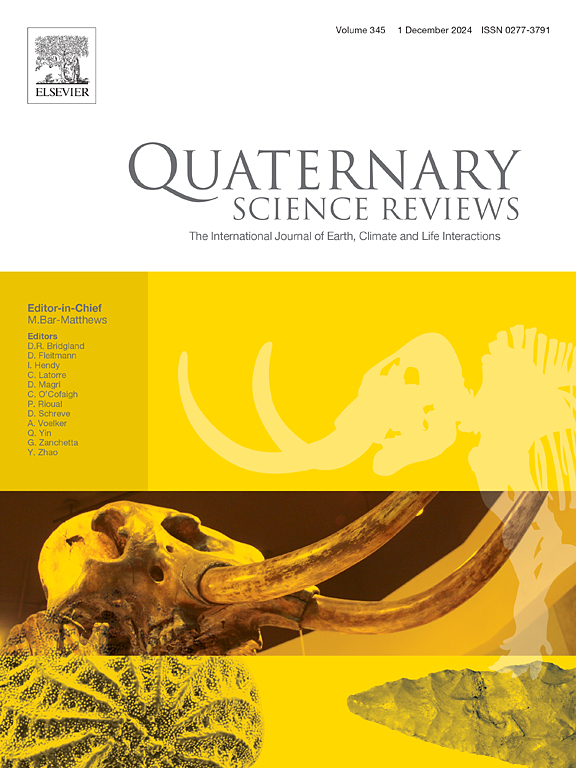Central South Pacific bottom water response to thermohaline circulation crisis during the Middle Pleistocene Transition
IF 3.2
1区 地球科学
Q1 GEOGRAPHY, PHYSICAL
引用次数: 0
Abstract
Mid-Pleistocene Transition (MPT) is still enigmatic in paleoclimatology, and the major disruption of the ocean thermohaline circulation (THC) system, which is known as the THC crisis during the MPT from ∼950 to 860 thousand years ago, is even more puzzling. Hence, benthic foraminifera and Iceberg rafted debris (IRD) of the Central South Pacific (CSP), International Ocean Discovery Program Site U1540 are examined, and compared with existing Nd isotope records (εNd) from the South and North Atlantic, and δ13C of South Atlantic and Equatorial Pacific to evaluate the properties and influence of CSP bottom water during THC crisis in comparison to pre and post-THC crisis. Our data suggests variability in CSP bottom water conditions from oxic to suboxic throughout the MPT. During the pre-THC crisis (MIS 38-26), bottom water was suboxic with low bottom water current strength, which continued up to the Marine Isotopic Stage (MIS) 25, except for MIS 31. Evidence of a strong bottom water current with a high oxic species population and low IRD is found at MIS 31. During the THC crisis, between MIS 25 and 23, a sharp decline in the coarse sediment fraction (>63 μm), oxic species and Globocassidulina subglobosa population is observed, which suggests sluggish bottom water at the CSP. However, during MIS 22, bottom water was relatively strong, marked by an increase in G. subglobosa and Nuttallides umbonifera and oxic species abundances. This suggests stronger southern source bottom water, which may reach up to the North Atlantic due to reduced northern sourced bottom water mass and is consistent with the interpretation of observed ɛNd value. After the THC crisis, bottom water became better oxygenated, especially during the interglacials with high bottom water current strength, which continued post-MPT period. Bottom water current strength nearly follows the ACC strength during the MPT except for MIS 22.
中更新世过渡时期中南太平洋底水对热盐环流危机的响应
在古气候学中,中更新世转变(MPT)仍然是一个谜,而海洋热盐环流(THC)系统的主要中断,即在约95至86万年前的MPT期间被称为THC危机,更是令人费解。为此,本文研究了国际海洋发现计划U1540站点中南太平洋(CSP)的底栖有孔虫和冰山漂流碎屑(IRD),并与现有的南大西洋和北大西洋Nd同位素记录(εNd)以及南大西洋和赤道太平洋的δ13C进行了比较,比较了THC危机前后CSP底水的性质及其影响。我们的数据表明,在整个MPT中,CSP底部水条件从氧到亚氧的变化。在thc危机前(MIS 38 ~ 26),底层水为低氧,底层水流强度低,一直持续到海洋同位素阶段(MIS 31) 25。有证据表明,在MIS 31处发现了强底水流、高氧物种种群和低IRD。在THC危机期间,在MIS 25和MIS 23之间,观察到粗沉积物组分(>63 μm),氧化物种和Globocassidulina subglobosa种群急剧下降,这表明CSP的底部水处于缓慢状态。然而,在MIS 22期间,底水相对较强,以G. subglobosa和Nuttallides umbonifera和含氧物种丰度增加为特征。这表明南部源底水较强,可能由于北部源底水质量减少而到达北大西洋,这与观测到的Nd值的解释一致。THC危机后,底部水的含氧状况得到改善,特别是在间冰期,底部水流强度较高,这种情况在mpt期后继续存在。除MIS 22外,MPT期间底水流强度与ACC强度基本一致。
本文章由计算机程序翻译,如有差异,请以英文原文为准。
求助全文
约1分钟内获得全文
求助全文
来源期刊

Quaternary Science Reviews
地学-地球科学综合
CiteScore
7.50
自引率
15.00%
发文量
388
审稿时长
3 months
期刊介绍:
Quaternary Science Reviews caters for all aspects of Quaternary science, and includes, for example, geology, geomorphology, geography, archaeology, soil science, palaeobotany, palaeontology, palaeoclimatology and the full range of applicable dating methods. The dividing line between what constitutes the review paper and one which contains new original data is not easy to establish, so QSR also publishes papers with new data especially if these perform a review function. All the Quaternary sciences are changing rapidly and subject to re-evaluation as the pace of discovery quickens; thus the diverse but comprehensive role of Quaternary Science Reviews keeps readers abreast of the wider issues relating to new developments in the field.
 求助内容:
求助内容: 应助结果提醒方式:
应助结果提醒方式:


